Douglas A-4F Skyhawk
Super 44 Edition

Eduard, 1/144 scale
S
u m m a r y |
| Catalogue Number and Price: |
Eduard Kit No. EDK4466 - Douglas A-4F Skyhawk Super 44 Edition
USD$12.95 plus shipping available online from Eduard
GBP£7.99 EU Price (GBP£6.66 Export Price) plus shipping available online from Hannants
and hobby retailers worldwide
|
| Scale: |
1/144 |
| Contents and Media: |
Three grey injection moulded sprues containing 46 parts, 1 sheet of decals, masks and an 8 page instruction booklet |
| Review Type: |
Re-released with new schemes. |
| Advantages: |
A kit with crisp yet subtle moulding with good level of detail, Eduard’s usual high quality instructions. It has 4 colourful schemes offeredo. |
| Disadvantages: |
|
| Conclusion: |
A chance to add a well detailed, yet fairly simple construction kit with colourful USN jet schemes. A nice kit! |
Reviewed by David Couche

The Douglas A-4 Skyhawk is a single-seat subsonic carrier-capable light attack aircraft developed for the United States Navy and United States Marine Corps in the early 1950s. The delta-winged, single turbojet engined Skyhawk was designed and produced by Douglas Aircraft Company, and later by McDonnell Douglas. It was originally designated A4D under the U.S. Navy's pre-1962 designation system.
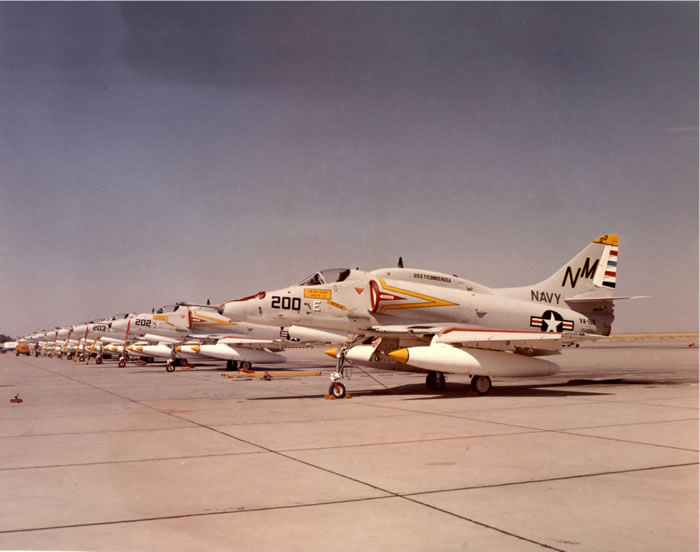
The Skyhawk is a relatively lightweight aircraft, with a maximum takeoff weight of 24,500 pounds (11,100 kg), and has a top speed of 670 miles per hour (1,080 km/h). The aircraft's five hardpoints support a variety of missiles, bombs, and other munitions. It is capable of carrying a bomb load equivalent to that of a World War II–era Boeing B-17 bomber, and can deliver nuclear weapons using a low-altitude bombing system and a "loft" delivery technique. The A-4 was originally powered by the Wright J65 turbojet engine; from the A-4E onwards, the Pratt & Whitney J52 engine was used.

Skyhawks played key roles in the Vietnam War, the Yom Kippur War, and the Falklands War. Sixty years after the aircraft's first flight in 1954, some of the 2,960 produced (through February 1979) remain in service with the Argentine Air Force and the Brazilian Naval Aviation.
The Skyhawk was designed by Douglas Aircraft's Ed Heinemann in response to a U.S. Navy call for a jet-powered attack aircraft to replace the older Douglas AD Skyraider (later redesignated A-1 Skyraider). Heinemann opted for a design that would minimize its size, weight, and complexity. The result was an aircraft that weighed only half of the Navy's weight specification. It had a wing so compact that it did not need to be folded for carrier stowage. The first 500 production examples cost an average of $860,000 each, less than the Navy's one million dollar maximum. The diminutive Skyhawk soon received the nicknames "Scooter", "Kiddiecar", "Bantam Bomber", "Tinker Toy Bomber", and, on account of its speed and nimble performance, "Heinemann's Hot-Rod". The XA4D-1 prototype set a world speed record of 695.163 mph on 15 October 1955
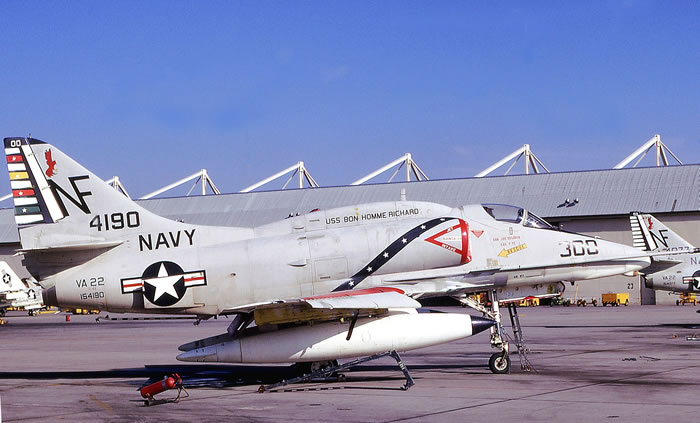
The aircraft is of conventional post-World War II design, with a low-mounted delta wing, tricycle undercarriage, and a single turbojet engine in the rear fuselage, with two air intakes on the fuselage sides. The tail is of cruciform design, with the horizontal stabilizer mounted above the fuselage. Armament consisted of two 20 mm (.79 in caliber) Colt Mk 12 cannons, one in each wing root, with 100 rounds per gun (the A-4M Skyhawk II and types based on the A-4M have 200 rounds per gun), plus a large variety of bombs, rockets, and missiles carried on a hardpoint under the fuselage centerline and hardpoints under each wing (originally one per wing, later two).
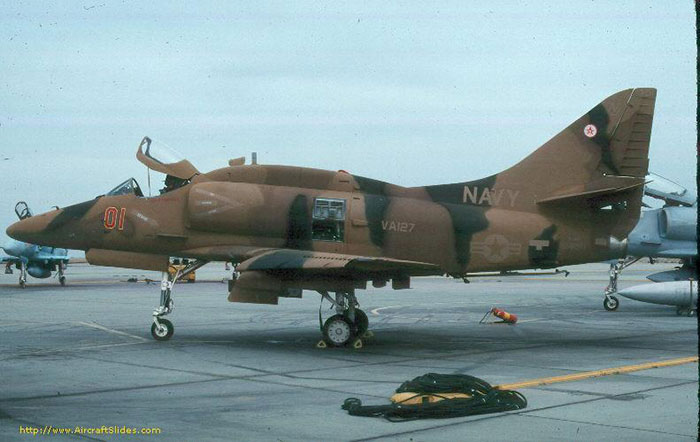
Refinement of A-4E with extra avionics housed in a hump on the fuselage spine (this feature later retrofitted to A-4Es and some A-4Cs), wing-top spoilers to reduce landing roll out, nose wheel steering, and more powerful J52-P-8A engine with 9,300 lbf (41 kN) of thrust, later upgraded in service to J52-P-408 with 11,200 lbf (50 kN), 147 built. Some served with Blue Angels acrobatic team from 1973 to 1986.
- Text mostly from Wikipedia
The Eduard kit comes in a large plastic bag (close to A4 size) with a cardboard centre to it, so it is relatively sturdy. This kit was originally the Platz released kit from 2009, which was one of the best 1/144 kits released for a long while. Inside the large contains the sprue trees in a separate plastic bag for safe transport. This contains 3 sprues of grey injected moulded, nicely detailed parts with 46 parts on them which enables you build a very nicely detailed model, but small model, quite simply. There is a smallish sheet of decals and the usual comprehensive instruction booklet, about A5 size of 8 pages. Eduard supplies a mask set as well with this little kit.
All sprues are fairly cleanly moulded with a little flash evident, and have a mix of raised and recessed detail as is required. The recessed detail is quite appropriate for the scale of the kit. The cockpit detail is very basic with only an ejection sheet in it, as are the wheel wells. Eduard do make an etch set for this kit but that would need to be purchased as an extra.
Sprue A

Sprue A has the fuselage halves on it as well as the separate intake sections, the seat, nose wheel, main wheels, 2 pylons and the refuelling probe. The sprue has 13 grey injected moulded parts Found here are the nicely detailed fuselages, with tails on both halves and the rudder on one to help with part alignment when assembling. Your will need to clean some of the parts as there is some minor flash but not really a problem.
Sprue C
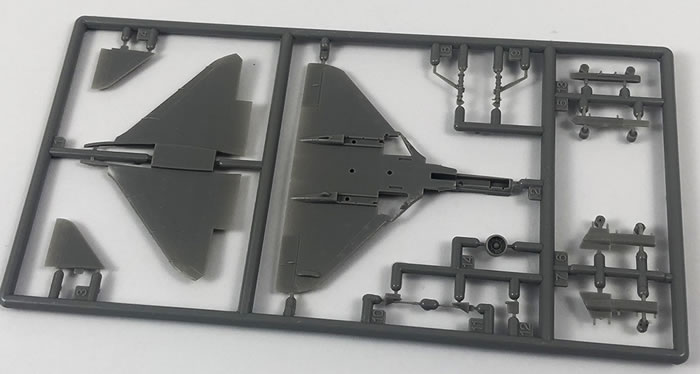
Sprue C has only 6 parts parts and these are for the 2 underwing drop tanks. The Wing pylons are integrally moulded to the tanks. The tanks are spilt in halves with a full piece tail section to add.
Instructions and Decals

The instructions for the kit are the usual Eduard, with a glossy booklet of 8 A5 pages of high quality detailed instructions, with copious colour call outs throughout, using the Gunze Aqueous, Mr Color as well as the Mission Models range. The decals are printed by Eduard and appear to be in perfect register giving the options for 4 different aircraft. A masking set gives you masks for the wheels and the canopy, which is certainly a big help.
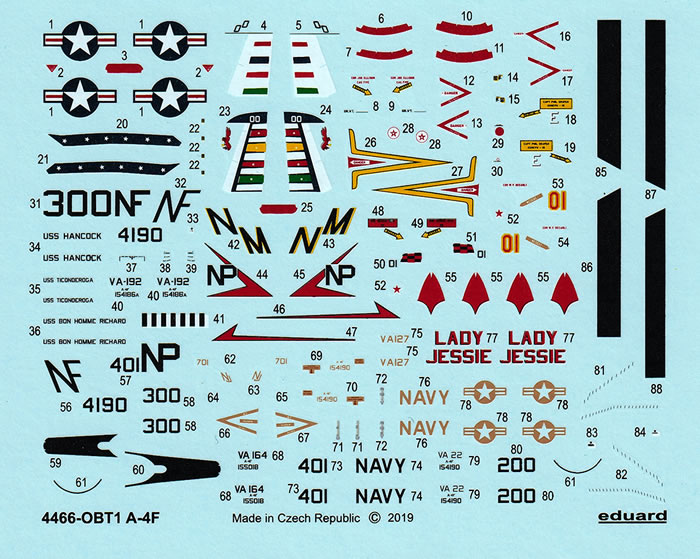
Four marking options are supplied, three of which are grey over white, with marking option B machine sporting a three colour wrap around camo scheme in tan, brown and green.
The four options are:
-
A-4F, BuNo 154186, VA-192 "Golden Dragons", USS Ticonderoga, 1968.
-
A-4F, BuNo 154190, VA-127, "Desert Bogeys", NAS Fallon, 1983-1986.
-
A-4F, BuNo 154190, VA-22, "Fighting Redcocks", USS Bon Homme Richard, 1970.
-
A-4F, BuNo 155018, VA-164, "Ghostriders", USS Hancock, 1971
Eduard have again released the previously boxed Platz kit with a set of new decals and masks. This kit will build into a lovely very small scale quality model and certainly will bring some brightness to your model cabinet with the great colourful schemes. A highly recommended kit for the ‘micro’ scale jet modeller. I can’t wait to get building on this one.
Thanks to Eduard for the sample
Review Text Copyright © 2020 by David Couche
Page Created 21 July, 2020
Last updated
21 July, 2020
Back to HyperScale Main Page
Back to Reviews Page |
